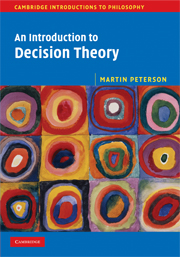Book contents
- Frontmatter
- Contents
- Preface
- 1 Introduction
- 2 The decision matrix
- 3 Decisions under ignorance
- 4 Decisions under risk
- 5 Utility
- 6 The mathematics of probability
- 7 The philosophy of probability
- 8 Why should we accept the preference axioms?
- 9 Causal vs. evidential decision theory
- 10 Bayesian vs. non-Bayesian decision theory
- 11 Game theory I: Basic concepts and zero-sum games
- 12 Game theory II: Nonzero-sum and cooperative games
- 13 Social choice theory
- 14 Overview of descriptive decision theory
- Appendix A Glossary
- Appendix B Proof of the von Neumann–Morgenstern theorem
- Further reading
- Index
Appendix B - Proof of the von Neumann–Morgenstern theorem
- Frontmatter
- Contents
- Preface
- 1 Introduction
- 2 The decision matrix
- 3 Decisions under ignorance
- 4 Decisions under risk
- 5 Utility
- 6 The mathematics of probability
- 7 The philosophy of probability
- 8 Why should we accept the preference axioms?
- 9 Causal vs. evidential decision theory
- 10 Bayesian vs. non-Bayesian decision theory
- 11 Game theory I: Basic concepts and zero-sum games
- 12 Game theory II: Nonzero-sum and cooperative games
- 13 Social choice theory
- 14 Overview of descriptive decision theory
- Appendix A Glossary
- Appendix B Proof of the von Neumann–Morgenstern theorem
- Further reading
- Index
Summary
The von Neumann–Morgenstern theorem (Theorem 5.2) on page 101 is an if-and-only-if claim, so we have to prove both directions of the biconditional. We first show that the axioms entail the existence part of the theorem, saying that there exists a utility function satisfying (1) and (2). In the second part of the proof, the uniqueness part, we prove that the utility function is unique in the sense articulated in (3). Finally, in the third part, we prove that if we have a utility function with properties (1)–(3) then the four axioms all hold true.
Part One
Let us start by constructing the utility function u mentioned in the theorem. Since Z is a finite set of basic prizes the completeness axiom entails that Z will contain some optimal element O and some worst element W. This means that O is preferred to or equally as good as every other element in Z, and every element in Z is preferred to or equally as good as W. Furthermore, O and W will also be the optimal and worst elements in all probabilistic mixtures of Z, i.e. in the set L. This follows from the independence axiom.
- Type
- Chapter
- Information
- An Introduction to Decision Theory , pp. 302 - 307Publisher: Cambridge University PressPrint publication year: 2009

